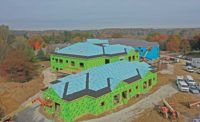In Luzerne County in northeastern Pennsylvania, former mine land is well on the way to becoming a hub of e-commerce. Hanover 9 is one of several projects in the county that involve reclaiming old mining sites and converting them to commercial and industrial use. It is a huge project—2 million sq ft of distribution centers—on an exceptionally fast track of about one year, and it is set to be completed in August. What’s more, the site had previously been viewed as undevelopable.
In 1994, Earth Conservancy, a nonprofit organization based in the county, purchased the Blue Coal Corp. and its 16,000 acres of land out of bankruptcy. Over more than three decades, the group has worked with state and federal agencies to reclaim parcels of the land, including the 390-acre Hanover 9 site.
Mike Dziak, Earth Conservancy president and CEO, says the property had been extensively damaged when strip mining was used to search for residual coal on the site. That resulted in large pits and mounds of waste. “Mining companies weren’t very regulated back then,” he says. People also used the property as an illegal dumping site.
But between 2011 and 2014, Earth Conservancy was able to fully reclaim the site.
With its proximity to the South Valley Parkway, an important transportation artery, the site was a target for developers of distribution centers and warehouses that need easy highway access. Last year, Missouri-based NorthPoint Development committed to develop the site, planning a $209-million project that includes a 1.4-million-sq-ft building, which it claims will be the largest commercial structure in northeastern Pennsylvania.
“Some of these [rock] piles were more than 60 feet tall.”
– Jim Trigg, Project Manager, Clayco
Although the site was technically reclaimed through the efforts of Earth Conservancy and its contractors, several site issues remained. The site was controlled by Kriger Construction, which had been on the construction team for the adjacent South Valley Parkway. Rock blasted out during that project was stored on the Hanover 9 site, where Kriger set up a crushing operation to create aggregate.
Jim Trigg, project manager with Clayco, the project’s general contractor, says that when he first inspected the site in July 2018, he found more than 1 million cu ft of rock piled up there. “Some of these piles were more than 60 feet tall,” Trigg recalls.
To help ease the process, Clayco contracted Kriger to do sitework for Hanover 9. The team was able to work around the piles of rock and move them as needed. But moving a million cu ft of rock isn’t a quick job, so the geotechnical engineer was only able to complete soil test borings on about one-third of the site.
Much of the existing rock could be used during construction as aggregate for paving and slab on grade. Another advantage created by the rock piles was that they served as a means of supercharging areas of the site to make sure soils were properly compacted. However, Trigg says that most of the site, which is set on a slope, required additional dynamic compaction.
Trees also needed to be removed, but the area is environmentally sensitive, particularly as a potential habitat for bats. A chiropterologist surveyed the site and determined that it was an ideal location for bats, so trees could only be cleared from Nov. 15 to May 15.
As work started to pick up in the fall of 2018, the region experienced one of its rainiest seasons on record. In total, the site received more than 50 in. of rain, resulting in 52 weather-related delay days. Numerous streams and wells also were discovered that flowed through the pad sites and had to be diverted.
Following the rainy fall, the area experienced severe cold snaps during the winter due to a polar vortex that settled over the region. Trigg says that while work was getting started on the pad for one of the buildings, temperatures dipped to 25 degrees below zero. The frozen conditions made it difficult for crews to work, but proved good for supporting soil.
Trigg says all of that changed when sub-zero conditions reversed and the soils began to thaw. “We had stabilized a 110,000-sq-ft area when we had the polar vortex,” he recalls. “Six days later it was 62 degrees. When we started digging the perimeter, the crews were digging and the entire perimeter foundation had water flowing into it and it was collapsing in,” Trigg says. “Everything we’d done failed.”
To stay on schedule, Clayco worked with geotechnical engineer Advantage Engineers to create a “bulletproof” solution. Crews excavated between 2 ft and 4 ft of the pad, depending on conditions, and brought in R4 rock, which is between 6 in. and 12 in. in diameter. The building pad required 207,407 cu yd of rock, sourced from existing piles on site. “Part of the advantage of the R4 rock was that it allowed water to drain under the building pad,” Trigg says.
In total, more than 2 million cu yd of earth was moved on the Hanover 9 site. In addition, 450,000 cu yd of rock had to be blasted. To stay on schedule, blasting was conducted while construction was underway, sometimes within 100 ft of footings.
With the pads established, crews could shift efforts to conventional foundations and tilt-up construction. The foundations are 18 in. deep with 3-ft perimeter footings and a 7-in. unreinforced slab. A total of 58,554 cu yd of concrete was poured on the project.
Although the construction type is conventional, the schedule was significantly accelerated, sometimes requiring creative resequencing of activities. Crews were able to complete 300 linear ft of foundation work and 30 perimeter columns per day. Piles of rock remained around portions of the building construction. “We were building the walls around the rock piles at one point with crushed rock still sitting on the building pad,” Trigg says.
The structural steel buildings are clad with insulated precast. With bay heights of more than 40 ft, the precast was too heavy to brace it to the slab, Trigg says. Crews had to drill in rock below the site to anchor the precast.
Due to the need for speed and continued concerns about weather, Clayco sequenced the roof work ahead of the slab work to keep the slab area covered. As soon as slabs were completed, areas could be turned over for tenant work. Trigg says the tenant’s information technology department “was able to bring in its racking one week after we got the slabs done.”
Similar to the crews’ pace of foundation work, they have been able to complete about 300 linear ft of precast per day with a goal of completing all precast work in less than 20 days.
The 600,000-sq-ft building was turned over in May. As of early June, crews were finishing work on the 1.4-million-sq-ft building, which is on track for an Aug. 1 completion. Anthony Johnson, Clayco executive vice president, adds, “That’s 2 million square feet that has popped up on sites that were once considered undevelopable.”








Post a comment to this article
Report Abusive Comment